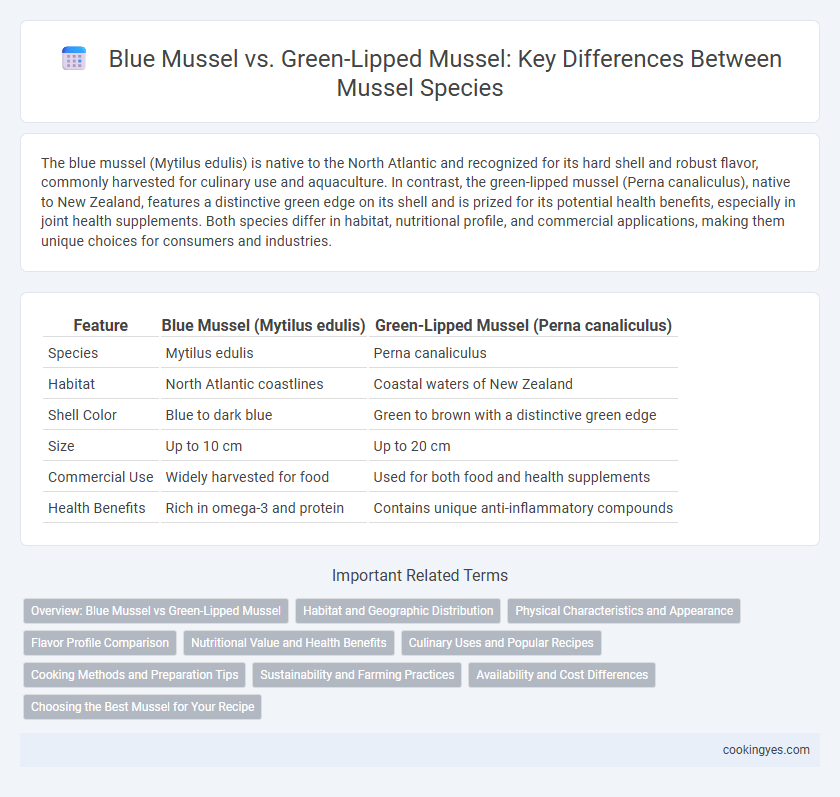The blue mussel (Mytilus edulis) is native to the North Atlantic and recognized for its hard shell and robust flavor, commonly harvested for culinary use and aquaculture. In contrast, the green-lipped mussel (Perna canaliculus), native to New Zealand, features a distinctive green edge on its shell and is prized for its potential health benefits, especially in joint health supplements. Both species differ in habitat, nutritional profile, and commercial applications, making them unique choices for consumers and industries.
Table of Comparison
| Feature | Blue Mussel (Mytilus edulis) | Green-Lipped Mussel (Perna canaliculus) |
|---|---|---|
| Species | Mytilus edulis | Perna canaliculus |
| Habitat | North Atlantic coastlines | Coastal waters of New Zealand |
| Shell Color | Blue to dark blue | Green to brown with a distinctive green edge |
| Size | Up to 10 cm | Up to 20 cm |
| Commercial Use | Widely harvested for food | Used for both food and health supplements |
| Health Benefits | Rich in omega-3 and protein | Contains unique anti-inflammatory compounds |
Overview: Blue Mussel vs Green-Lipped Mussel
The Blue mussel (Mytilus edulis) is a widely distributed bivalve known for its high adaptability to various marine environments and significant commercial value in Europe and North America. The Green-lipped mussel (Perna canaliculus) is native to New Zealand, distinguished by its vibrant green shell edge and renowned for its anti-inflammatory properties and nutritional benefits. Both species contribute substantially to aquaculture, but the Green-lipped mussel is particularly favored for dietary supplements due to its unique omega-3 fatty acid profile.
Habitat and Geographic Distribution
Blue mussels (Mytilus edulis) inhabit colder coastal waters of the North Atlantic Ocean, thriving in intertidal zones along North America, Europe, and parts of Asia. Green-lipped mussels (Perna canaliculus) are native to the subtropical and temperate coastal waters surrounding New Zealand, favoring sandy or rocky substrates in sheltered estuaries. The distinct habitats influence their physiological adaptations and commercial harvesting regions.
Physical Characteristics and Appearance
Blue mussels (Mytilus edulis) have smooth, elongated shells with a deep blue to black coloration, often displaying subtle concentric ridges and a shiny surface. Green-lipped mussels (Perna canaliculus) feature larger, thicker shells with a distinctive greenish edge on the lip and a more robust, oval shape, with ridges that are more prominent and textured. These physical differences aid in species identification and reflect adaptations to their native habitats, with blue mussels common in colder Atlantic waters and green-lipped mussels native to New Zealand's warmer coastal environments.
Flavor Profile Comparison
Blue mussels (Mytilus edulis) offer a mild, slightly sweet flavor with a firm, plump texture, making them popular in a variety of culinary dishes. Green-lipped mussels (Perna canaliculus) have a more intense, briny taste with a buttery richness and a softer, meatier bite, prized especially in New Zealand cuisine. The blue mussel's subtle oceanic notes contrast with the green-lipped mussel's robust, umami-packed flavor, influencing their preferred cooking methods and complementary ingredients.
Nutritional Value and Health Benefits
Blue mussels (Mytilus edulis) are rich in omega-3 fatty acids, high-quality protein, and essential minerals such as iron and zinc, promoting cardiovascular health and muscle function. Green-lipped mussels (Perna canaliculus) contain unique anti-inflammatory compounds, including omega-3 fatty acids and glycosaminoglycans, which support joint health and reduce symptoms of arthritis. Both species offer substantial nutritional benefits, but green-lipped mussels are particularly valued for their potent therapeutic effects on inflammation and joint-related conditions.
Culinary Uses and Popular Recipes
Blue mussels (Mytilus edulis) are widely used in European cuisine, prized for their tender texture and briny flavor ideal for classic dishes like moules marinieres and seafood stews. Green-lipped mussels (Perna canaliculus), native to New Zealand, are favored in health-oriented recipes and stir-fries due to their slightly sweeter taste and higher omega-3 content. Both species are commonly steamed, grilled, or incorporated into pasta and chowder, showcasing versatile culinary applications that highlight regional flavors.
Cooking Methods and Preparation Tips
Blue mussels (Mytilus edulis) have a tender texture and mild flavor, making them ideal for steaming, boiling, or baking with garlic and white wine; their shells open easily during cooking, signaling readiness. Green-lipped mussels (Perna canaliculus) possess a firmer texture and slightly sweeter taste, best suited for grilling or poaching to preserve their unique flavor and vibrant green shell edges. Both species benefit from thorough rinsing and debearding before cooking to remove sand and ensure optimal taste and texture.
Sustainability and Farming Practices
Blue mussels (Mytilus edulis) are native to the North Atlantic and are considered highly sustainable due to their efficient filter-feeding and low-impact wild harvesting methods. Green-lipped mussels (Perna canaliculus), native to New Zealand, are primarily farmed using environmentally friendly aquaculture techniques that minimize habitat disruption and promote water quality. Both species contribute to sustainable seafood production by requiring minimal feed inputs and supporting marine ecosystem health.
Availability and Cost Differences
Blue mussels (Mytilus edulis) are widely available and commonly harvested in the North Atlantic, making them more affordable and accessible in markets globally. Green-lipped mussels (Perna canaliculus) originate from New Zealand, where controlled aquaculture limits supply, resulting in higher costs and premium pricing. The geographic specificity and farming methods of green-lipped mussels contribute to their scarcity and price disparity compared to the more abundant blue mussels.
Choosing the Best Mussel for Your Recipe
Blue mussels (Mytilus edulis) offer a tender texture and mild flavor, making them ideal for classic dishes like moules marinieres and seafood stews. Green-lipped mussels (Perna canaliculus), native to New Zealand, are larger with a slightly sweet, briny taste and firmer texture, perfect for grilled or baked recipes that highlight their unique flavor. Selecting between blue and green-lipped mussels depends on the desired texture and intensity of flavor in your dish, as well as regional availability and freshness.
Blue mussel vs Green-lipped mussel for species Infographic

 cookingyes.com
cookingyes.com